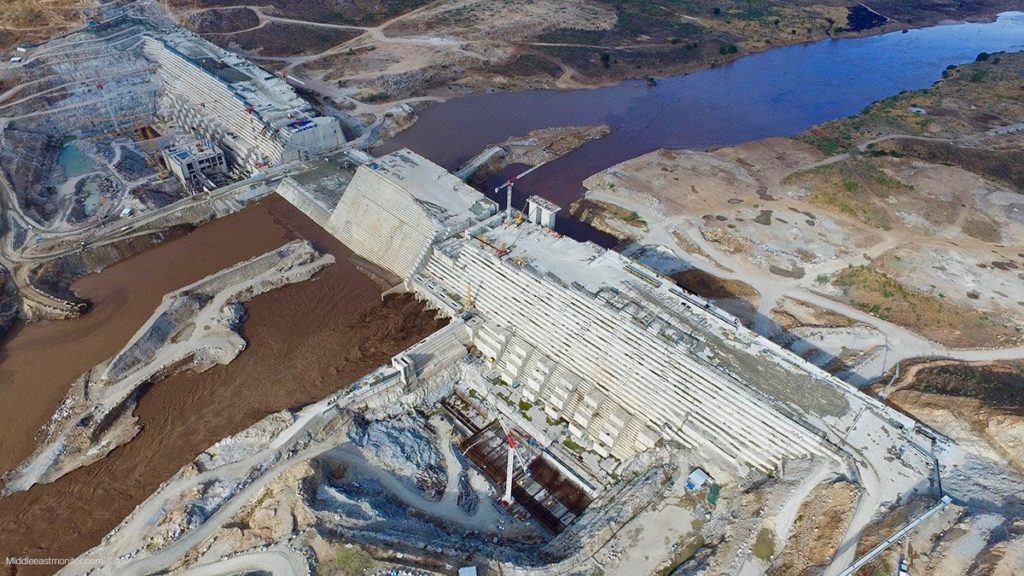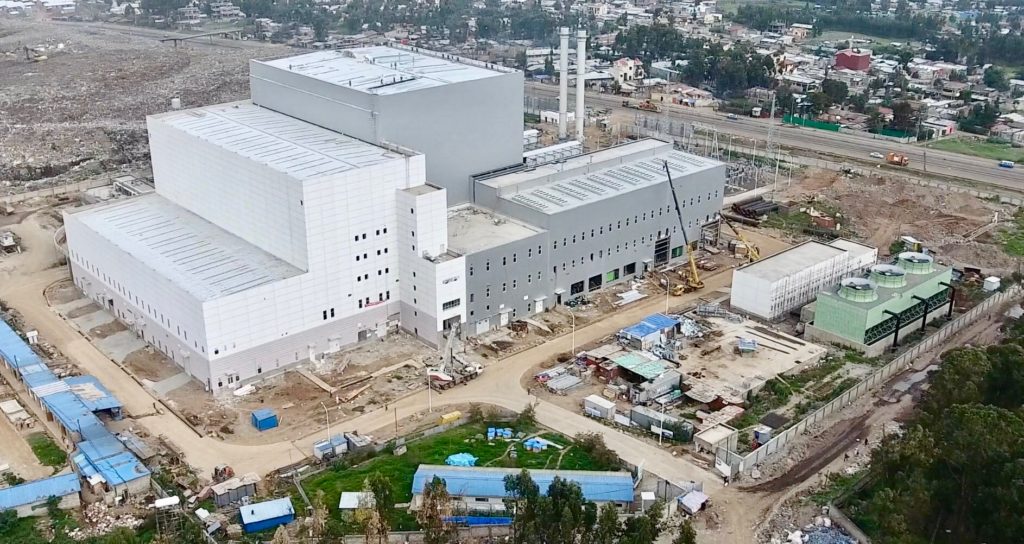Ethiopia is expected to considerably step up its electricity production capacity in 2018. The Grand Ethiopian Renaissance Dam (GERD) will start generating electricity as the first two 375 MW turbines will enter into service. In parallel, the National Electrification Program (NEP) will help the country’s objective to reach universal access by 2025. This article was originally published in the 9th issue (January 2018) of The Ethiopian Messenger, the quarterly magazine of the Embassy of Ethiopia in Brussels.

The Grand Ethiopian Renaissance Dam, whose construction started in 2011, will start generating power this year
Next year, Ethiopia is expected to considerably step up its electricity production capacity and achieve other stepping stones in its the energy sector. The Grand Ethiopian Renaissance Dam, a landmark project in Ethiopia’s endeavour to become a middle-income country by 2025, will start generating electricity as the first two 375 MW turbines will enter into service. In parallel, the National Electrification Program (NEP) was launched in order to increase the access of the population to the electrical network. Universal access should be reached by 2025 using both on-grid and off-grid solutions.
The Grand Ethiopian Renaissance Dam: starting operations
Built on the Blue Nile in Ethiopia since 2011, the Grand Ethiopian Renaissance Dam (GERD) is expected to start generating hydroelectric power in 2018. Two of the sixteen turbines will be activated, with a generating power of 750 MW of electricity. Upon completion, the dam will be Africa’s largest with an installed capacity of 6,450 MW − equivalent to four to six nuclear reactors −, and it will double Ethiopia’s total capacity, that is expected to reach an approximate 14,000 MW upon completion of ongoing projects including the Koysho dam that is currently being built. The construction site is currently the biggest in Africa, with 10,000 men and women working day and night to achieve this gigantic national effort. Once completed, the Grand Ethiopian Dam will be the largest dam on the continent: 1,780 meters long and 145 meters high. Built for an estimated cost of 4.7 billion USD thanks to entirely domestic funds, the dam has been considered to be a landmark project signalling Ethiopia’s Renaissance.
Since the GERD is being constructed on the Blue Nile, that has its source in Ethiopia and flows to Sudan and Egypt, Ethiopia took the initiative to establish international consultations with the other riparian countries. A major step was achieved on 23 March 2015 in Khartoum, when the leaders of Egypt, Ethiopia and Sudan signed a declaration of principle on Ethiopia’s Grand Renaissance dam project. “We could cooperate and accomplish great things or disagree and hurt each other… we have chosen to cooperate,” the Egyptian President El-Sisi stated on this occasion. On his side, Ethiopia’s Prime Minister Hailemariam Desalegn stressed that the Renaissance Dam will not cause any significant harm to the Egyptian people: Egypt and the rest of the Nile Basin countries are one family, he said. Moreover, on 1st of June 2016, Egypt’s foreign affairs minister Sameh Shoukry noted that the Grand Ethiopian Renaissance Dam has become a reality and that it is “pointless to bury our heads in the sand by not acknowledging a tangible physical reality.” Two French consultancy firms – BRL and Artelia – were also selected to undertake studies on the possible impacts of the dam.
Regional agreement
Ethiopia is expected to considerably step up its electricity production capacity in 2018. The Grand Ethiopian Renaissance Dam (GERD) will start generating electricity as the first two 375 MW turbines will enter into service. In parallel, the National Electrification Program (NEP) will help the country’s objective to reach universal access by 2025.
In October 2017, Ethiopia facilitated a visit of Egypt, Ethiopia and Sudan signed a cooperation deal in March 2015 the Ministers of Water Affairs of Ethiopia, Egypt, to ensure a fair distribution of the dam resources and Sudan to further boost the existing level of transparency and increase confidence among the three countries about the Dam. During the visit, the Minister of water, irrigation, and electricity of Ethiopia, Engineer Sileshi Bekele, presented to his counterparts the major positive impacts the megaproject will have in Ethiopia as well as in the countries of the region upon its completion. On the next day, a trilateral ministerial meeting took place during which the pending issues regarding the International Panel of Experts (IPoE) and two recommended studies were discussed. During the meeting, Water Ministers of Ethiopia, Egypt, and Sudan drafted a guideline that will guide the activities of the two consulting firms in charge of conducting the impact analysis.
The assertion that the Grand Ethiopian Renaissance Dam has no significant impact on downstream countries is based on scientific research. Several studies carried out by Ethiopia have shown that the dam will have no significant negative hydrologic simulation, socio-economic, and environmental impacts on downstream countries. The country has so far provided about 150 documents related to the hydrological simulation and other issues in dealing with other parties in a transparent manner. Ethiopia has also taken into account the drought scenario in the water filling strategy, mean flow scenario, and high-water flows scenarios, which in turn minimize wastage of water and utilization throughout the year. Downstream countries will benefit from the renewable energy to be generated from the dam, which will serve as a water bank for both countries in case of drought. Sudan annually pays 50 million USD to clear the sands in its reservoir and irrigation dams and the GERD will reduce the possible accumulation of silt in the reservoirs and irrigation dams of both countries. Most importantly, the dam will have a paramount contribution towards eradicating poverty, maintaining economic growth and pushing for more regional integration.
With a hydropower potential of 45,000 MW largely untapped until today, Ethiopia has a real opportunity to transform its economy and accelerate the economic integration of the whole region thanks to cheap and abundant energy. The goal of the country is to reach a generating power of 17,000 MW by the end of the Growth and Transformation Plan in 2020. Plants constructed to this end during the last ten years include Tekeze (300MW, completed in 2009), Tana Belese (460 MW), Gilgel Gibe II (420 MW, completed in 2010), Gilgel Gibe III (1970 MW. Koysho Dam (2,200 MW) is currently under construction.
An expanding distribution network
On 27 November, the government of Ethiopia launched the National Electrification Program (NEP) to reach universal access by 2025, using both on-grid and off-grid solutions. The goal of the NEP is to better cover the country’s population and also provide electricity to neighbouring countries. Through the Grand Ethiopian Renaissance Dam, whose construction started in 2011, will start generating power this year the first phase of the program (2018-2022), 4.5 million new grid connections are anticipated. Launching the program, Prime Minister Hailemariam Desalegn said access to adequate, reliable and affordable electric service is a critical enabler to Ethiopia’s transformation into a middle- income country. The NEP will also enable the country to reach the corresponding UN Sustainable Development Goal target ahead of time by providing adequate, reliable and affordable electricity for all by 2030.
The program will be realized in collaboration with multilateral and bilateral financial institutions and development partners. About USD 1.5 billion of investment and technical assistance is expected to be covered by the government, multilateral and bilateral financial institutions and development partners as well as the private sector. In this framework, the World Bank is ready to confirm its support to the government of Ethiopia to realize its ambitious national electrification program and could extend 375 million USD in credit for the program.
A strong commitment to green economy
 The progress of Ethiopia’s energy sector expected for the year 2018 will represent an important step for the country on its way to economic development. As a matter of fact, cheap and abundant energy is crucial for the well-being of Ethiopian citizens, the development of the economy, tourism and especially for the industrial sector. Combined with a large, cheap and trainable labour force, robust infrastructure, political stability and a strategic location, the growth of the energy sector will boost the attractiveness of the country. Furthermore, these new electricity production facilities will enable Ethiopia to export cheap electricity to neighbouring countries.
The progress of Ethiopia’s energy sector expected for the year 2018 will represent an important step for the country on its way to economic development. As a matter of fact, cheap and abundant energy is crucial for the well-being of Ethiopian citizens, the development of the economy, tourism and especially for the industrial sector. Combined with a large, cheap and trainable labour force, robust infrastructure, political stability and a strategic location, the growth of the energy sector will boost the attractiveness of the country. Furthermore, these new electricity production facilities will enable Ethiopia to export cheap electricity to neighbouring countries.
This will have a positive effect on regional integration and development. The sustainable development lies at the very centre of Ethiopia’s economic strategy. This commitment has been demonstrated through the clean energy generation projects, through investments in electric transportation infrastructure (railway), extensive rural environmental rehabilitation works, among others. Various awareness creation programs regarding desertification and environmental rehabilitation work such as reforestation and afforestation have in fact been taking place country-wide and have been taken as an example in many parts of the world.
As a result, the country’s forest coverage has reached 15 percent, which was at an all-time low of less than 4 percent almost two decades ago. By concretely advancing towards the realization of a green economy, Ethiopia has enabled itself to play a leading role in international climate change negotiations. The country is currently engaged in a successful climate diplomacy so that the voice of developing countries is heard on this pressing issue on the international arena.
The innovative Reppie Waste-to-energy plant
Another landmark project for Ethiopia’s green economy will be the launch of the Reppie waste-to-energy plant in Addis Ababa. Starting in 2018, Ethiopia’s first waste-to-energy plant will produce 185 gigawatt GWh per year and protect the environment by diverting huge amounts of waste while covering 30 percent of the capital city’s household’s electricity needs. The facility located alongside the 50-year- old Koshe dump site is one of the various energy projects being implemented in line with Ethiopia’s Climate Resilient Green Economy (CRGE) strategy that aims to limit the country’s carbon footprint to less than 2010 levels by 2030 as it becomes a middle-income nation. The plant has been built according to the highest environmental and technical standards and will bet the first of its kind on the African continent. ■



